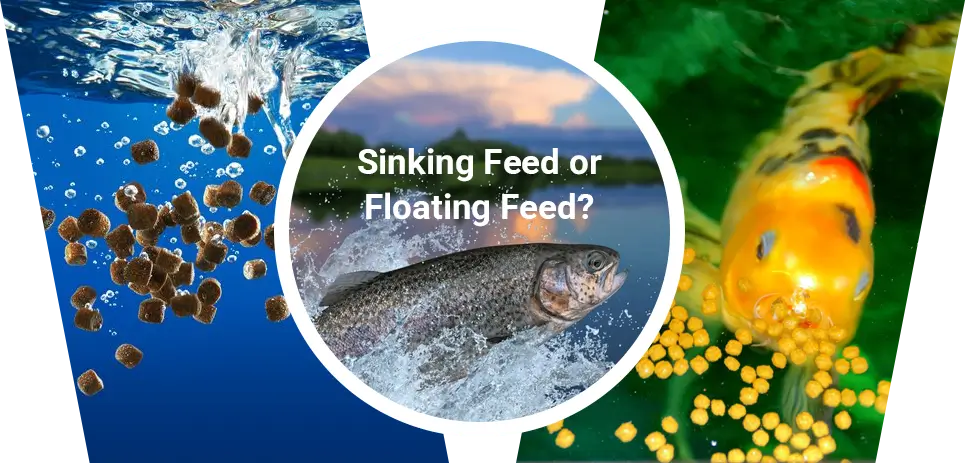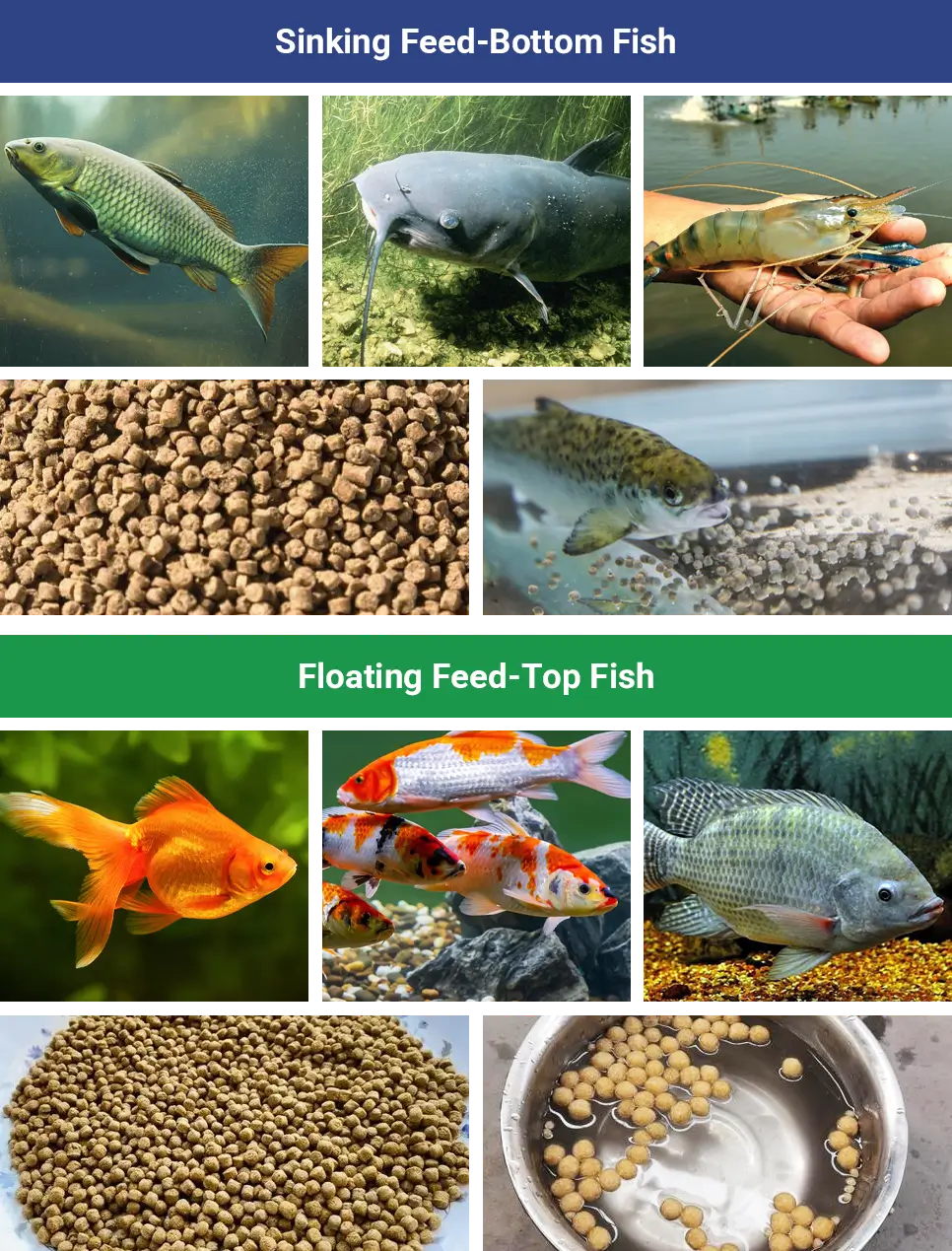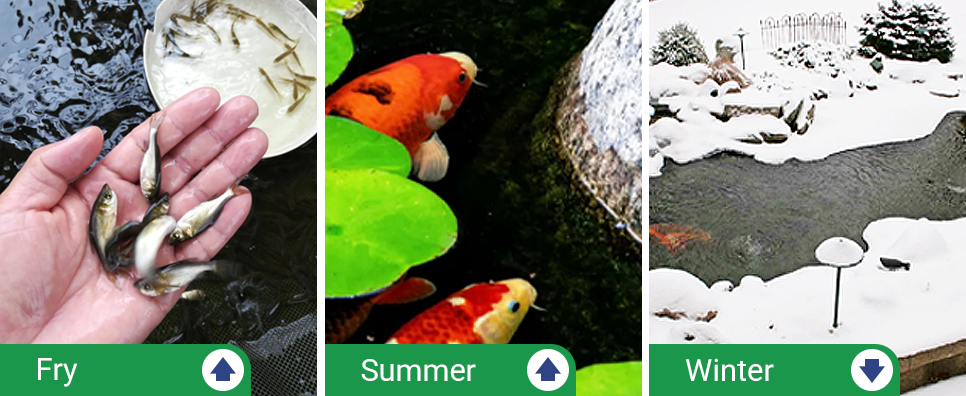Floating or Sinking Feed: What's Best for Your Fish?
Feed choice directly affects fish growth, health, and water quality. Different species feed differently-using the wrong feed leads to waste and higher disease risk. Whether feed floats or sinks also impacts feeding behavior and cleanup. Choosing the right type means better results and fewer problems.

Difference Between Floating and Sinking Feed
| Item | Sinking Fish Food | Floating Fish Food |
| In Water | Sinks fast | Floats on the surface |
| Lasts | 1–2 hours | 2+ hours, some over 12 hours |
| Ingredients | Heavy powders (e.g. fish meal) | Light stuff (e.g. corn, puffed starch) |
| For Fish | Bottom feeders | Surface or mid-level feeders |
| Digestibility | Slower to digest | Easier to digest |
| Water Quality | Harder to clean if uneaten | Easy to see and manage |
| Made By | Pellet machine | Extruder |
| Cost | Lower | Slightly higher |

Key Factors Affect Feed Floating and Sinking
One of the key factors affecting whether feed floats or sinks is pellet density.
Put simply, pellet density refers to the weight of feed per unit volume, usually measured in g/L (grams per liter). Heavier pellets sink; lighter ones float. Here's how different densities affect sinking and floating (at 20°C) :
| Type | Freshwater | Seawater (3% salinity) |
| Fast Sinking | > 600 g/L | > 640 g/L |
| Slow Sinking | 540–560 g/L | 580–600 g/L |
| Suspended | 480–520 g/L | 520–540 g/L |
| Floating | < 400 g/L | < 480 g/L |
Pellet density plays a big role in how feed sinks or floats-and it also affects how well your fish eat and grow. When picking feed, it's a detail worth paying attention to.
Which Feed Type Is Right for Your Fish?
Based on Fish Species
Different fish feed at different depths, which should be your first consideration when choosing feed type.
- Bottom-feeding species (e.g. catfish, carp, shrimp) → Best with sinking feed that stays near the bottom.
- Mid-to-surface feeders (e.g. grass carp, goldfish, koi) → Floating fish food encourages group feeding near the surface.
- Mixed pond fish food → Combine both types, or use slow-sinking fish pellets to suit various species.
Match to Your Farming Environment
Water depth, flow, and outdoor conditions can all affect feed performance.
- Deep ponds or large tanks → Sinking feed is more stable and less likely to drift.
- Shallow or fast-moving water → Floating feed is easier for fish to find and eat.
- Outdoor ponds with wind or waves → Sinking feed reduces floating feed loss.
Water Quality Management
Floating feed makes it easy to observe how fish are feeding, and any leftovers can be removed quickly-helping you keep the water clean.
If you use sinking feed, it's best to clean the pond bottom regularly or use a filtration system to prevent waste buildup and water pollution.
Cost & Efficiency
From a cost and efficiency standpoint, sinking feed is simpler to produce and more affordable-making it a good choice for large-scale farming. Floating feed costs more but offers better palatability and digestibility, which helps reduce waste and improve feed utilization. Choose based on your farming scale and production goals.
Special Feed Choices for Different Conditions
In daily aquaculture, fish growth stages and seasonal changes are often overlooked, but they directly affect feeding behavior and how well feed performs.
For Juvenile Fish
Fish fry are more sensitive to feed appearance and movement. Floating feed is easier to notice and stays on the surface longer, giving fish more time to eat. It's the better choice for fry and small juveniles.
In Hot Weather
High temperatures speed up feed breakdown in water. If floating fish food pellets disintegrate before fish can eat, it leads to waste. Choose floating feed with good water resistance and long float time. Also, fish tend to stay near the surface in summer due to lower oxygen levels-making floating feed more effective.
In Cold Weather
Fish eat more slowly at low temperatures. Sinking feed should sink gradually and stay intact for longer, so fish have time to find and eat it. Fast-breaking feed can lose nutrients and leave waste on the pond bottom, harming water quality.

FAQ
Is floating feed more expensive than sinking feed?
A bit, yes-because of the extrusion process. But it's easier to digest and creates less waste, so it often pays off over time. Sinking feed is cheaper and works well for large-scale farms.
Can I use floating feed for all fish?
Not really. It's great for surface feeders, but bottom feeders like catfish may eat less or get stressed. Better to match feed type to fish behavior.
Can I make floating feed with a pellet mill?
Usually no. Pellet mills make sinking food. Floating feed needs an extruder. But with the right formula, you can get slow-sinking or semi-floating results.
Can I mix floating and sinking feed?
Yes. It works well in mixed ponds. Just don't overfeed or feed both types in the same spot-leftovers can pollute the water.
Floating and sinking feeds each have their advantages. The right choice depends on your fish species, feeding habits, water management, and overall farming cost. And different types of feed require different processing methods.
If you're planning to make fish feed, feel free to contact us. We offer the right fish feed making machine for both extrusion and pelletizing.

 Online Contact
Online Contact Send Message
Send Message
Need Some Help?
Contact us quickly and we will reply you within 24 hours. We will not disclose your information.